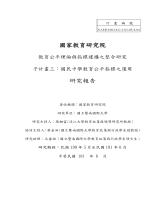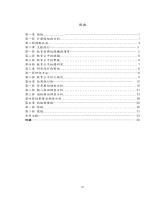教育公平理論與指標建構之整合研究子計畫三:國民中學教育公平指標之運用 研究報告
| 研究計畫及報告 | |
| 計畫類型 | 整合型計畫 |
| 計畫名稱 | 教育公平理論與指標建構之整合研究子計畫三:國民中學教育公平指標之運用 研究報告 |
| 整合型計畫名稱 | 教育公平議題與特定政策之整合研究 |
| 共同主持人 | 王如哲;陳伯璋;魯先華 |
| 計畫主持人 | 張鈿富;蔡金田 |
| 研究者 | 研究助理: 毛睿翎 |
| 執行機構 | 國家教育研究院 |
| 執行單位 | 國立暨南國際大學 |
| 年度 | 100 |
| 語文 | 中文 |
| 關鍵詞 | 國民中學;國民教育;教育公平;教育指標 |
| 關鍵詞(英) | compulsory education;education equity;education indicator;junior high school |
| 摘要 | |
| 英文摘要 | This study aimed to use the educational equity indicators of junior high school constructed during the first year to explore the current status of implementation in junior high schools. Document analysis, questionnaire survey, Gini coefficient and Lorenz curve are used in this study. The preliminary findings are as follows: (1)In terms of the distribution of students and schools, the five municipalities(Taipei, New Taipei, Taichung, Tainan and Kaohsiung) account for a major percentage, while the offshore islands, Matsu and Kinmen County, account for the least. (2)The percentage of junior high school education's expenditure in the total educational expenditure and the educational expenditure per student show a declining tendency. (3)In terms of the distribution of educational sources, the five municipalities still account for the largest percentage of hardware resources (sports or activity center, swimming pool, library book number). As for the software resources, the student-teacher ratio is the highest in Tainan City, Chiayi City, Changhua County and Pingtung County; the class size is the largest in the new Taipei City and Chiayi City; the ratio of teachers holding master's degrees is higher in Matsu, Taitung County and Taipei City. The distribution of educational sources of student in Junior High School. The Gini coefficient is between 0.113 and 0.194, It is a high degree of equalization. (4) The enrollment and the related compensation measures (financial support, compensation programs, remedial education) for those students who are disabled, from poor or special situation families are not yet fully implemented. (5)Most schools agree to make laws to regulate the responsibilities of different educational levels as well as against school bullying. (6) Few schools are still unable to implement the policy of normal class grouping. Group learning, remedial teaching, compensation courses, multicultural curriculum, friendly campus can still. (7)As for curriculum, teaching, assessment and teacher-student relationship, few schools are still unable to improve the quality of teacher-student interaction, to implement multiple assessments and course material design, and to offer counseling for students regarding adaptive development and career planning. |
| 授權狀態 | 已授權 |
章節標目
| 標題 | 頁數 | 全文 |
|---|---|---|
| 第一章 緒論 | 1-4 | |
| 第一節 計劃緣起與目的 | 1-4 |
|
| 第二節預期效益 | 4 |
|
| 第二章 文獻探討 | 5-8 |
|
| 第一節 教育指標的建構與運用 | 5-6 |
|
| 第二節 教育公平的議題 | 6 |
|
| 第三節 教育公平的實踐 | 6 |
|
| 第四節 教育公平相關研究 | 7-8 |
|
| 第三章 研究設計與實施 | 8-9 |
|
| 第一節研究方法 | 8-9 |
|
| 第二節 教育公平性之檢定 | 9 |
|
| 第四章 結果與討論 | 10-29 |
|
| 第一節 背景層面調查分析 | 10-21 |
|
| 第二節 輸入層面調查分析 | 21-23 |
|
| 第三節 過程層面調查分析 | 23-28 |
|
| 第四節結果層面調查分析 | 28-29 |
|
| 第五章 結論與建議 | 30-32 |
|
| 第一節 結論 | 30-31 |
|
| 第二節 建議 | 31-32 |
|
| 參考文獻 | 33-35 |
|
| 附錄:國民中學教育公平指標 | 36-41 |
|


